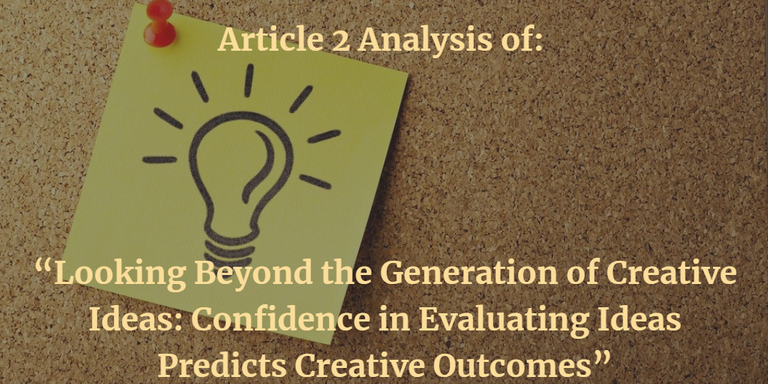
Introduction
The article that is the subject of this analysis is:
Looking Beyond the Generation of Creative Ideas: Confidence in Evaluating Ideas Predicts Creative Outcomes.
It is authored by Logan M. Steele, Genevieve Johnson, Kelsey E. Medeiros and published in Personality and Individual Differences, Volume 125, 15 April 2018, Pages 21-29. The article was originally submitted to the journal on 2 November 2017, it was then revised on 16 December 2017 and finally accepted by the journal on 18 December 2017.
The authors focus on creative self-efficacy as a predictor of a person’s creativity. Specifically, the authors focus on the evaluative aspects of creative self-efficacy. The authors point out that generative aspects of creative self-efficacy have been the most studied, while the evaluative aspects have been ignored.
Summary
The authors start with the typical introduction, which includes definitions and previous research of creativity and creative self-efficacy. They then outline their two studies; each outline speaks to the development of the study’s related hypotheses and provides the final hypothesis for each study. For each study, they provide a method, which includes measurement, results, and finally a discussion at the end of each study. They then provide a general discussion of both studies which include findings, implications, limitations and future directions then they conclude the article and acknowledge those who supported them with the research and paper.
The authors assert that creative self-efficacy has largely focused on the generative processes, and were hindered by theory and methods used, while excluding or ignoring evaluative processes, making the research incomplete or wrong. They propose the creation of measurement of the evaluative processes to complement the measurements for the generative processes to provide a more accurate prediction of creativity. They refer to this new metric as Idea Evaluation Self-Efficacy (IESE).
The authors developed four hypotheses between the two studies. Within each study, they had two hypotheses.
Study 1:
The first hypothesis was the existence of a positive relationship between conscientiousness and preference for evaluation to IESE. Idea evaluation self-efficacy will be positively related to (a) conscientiousness and (b) preference for evaluation. The second hypothesis is that there is no relationship between fixed creative attitudes and IESE.
Study 2:
The third hypothesis being a positive relationship of idea originality to Creative Self-Efficacy (CSE). The fourth hypothesis states there is a positive relationship between the utility of ideas with IESE.

Analysis
My analysis of this article is that the research is interesting, but still not thorough. There is a very limited demographic with a median age between both studies being 19 years of age and between around 72-73 percent being female and 77 percent being white. The research does not dig far enough into how age, gender, and racial factors may play a role in creative self-efficacy.
Although I do not believe age, gender or race itself plays a factor, I do believe organizational culture regarding these demographics can influence one’s creativity based on how organizations are perceived regarding diversity and acceptance of ideas. This may itself lead to even more important research in which we may, or may not, discover organizational culture and diversity, or lack of may have an impact on idea creation and self-efficacy, especially for women and those of non-white races.
The authors skewed their results by focusing on graduate students as their participants. This almost assured they would largely have a larger population of under 25, white, and female participants per the United States Census Bureau Tables on Educational Attainment in the United States: 2018 (US. Census Bureau, 2019).
Conclusion
If forming additional hypotheses for this paper, one would be that diversity within an organization is positively related to IESE and CSE.
More research should be done in these areas, to not only determine impacts of diversity, or lack of in the workforce but to find a way to build creativity across a diverse workforce.
References
US. Census Bureau. (2019). Educational Attainment in the United States: 2018. Washington, DC: United States Census Bureau.